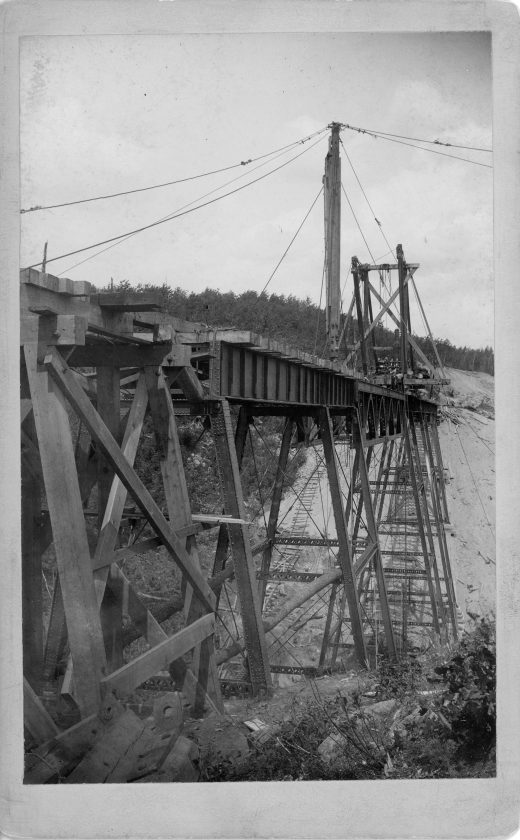A history of the Dead River Trestle
- The original bridge is shown in a photo taken by William C. Kepler. (Photo courtesy of the Marquette Regional History Center)
- a photo taken by Gustave A. Werner shows construction of the original bridge in June 1896. (Photo courtesy of the Marquette Regional History Center)
- The current bridge is pictured around the 1980s. The train is being pulled by LS&I Engine 2403 followed by two more engines in a newer paint style. (Photo courtesy of the Marquette Regional History Center)

The original bridge is shown in a photo taken by William C. Kepler. (Photo courtesy of the Marquette Regional History Center)
MARQUETTE — The Lake Superior and Ishpeming Railroad Company (LS&I) began operating in 1896, specializing in moving ore from Marquette County iron mines to Marquette Harbor, known as Iron Bay, where it was shipped throughout the Great Lakes. LS&I later expanded into transporting pulpwood, but iron ore was always its most important freight.
The company also moved passengers for a time, running lines from Marquette to Munising and Big Bay, but riders joked that LS&I meant Lazy, Slow, and Independent. LS&I made more money moving iron ore than people, and passengers were a bit of an afterthought.
In 1896, a wooden bridge was built across the steep gorge over a waterfall on the Dead River. The original wooden Dead River bridge structure was outdated within twenty years as rail traffic increased and the modernizing railroad industry began to use larger, heavier locomotives.
The current steel structure was built in 1916 by Wisconsin Bridge and Iron Co. The Milwaukee-based company also did other work in the Upper Peninsula, constructing bridges in Keweenaw County and Menominee County around the same time as the new Dead River Trestle.
Though it looks quite ordinary from above, the 565-foot-long Dead River Trestle was built according to an unusual design, unique in Michigan, making it something of an engineering marvel. It is essentially a very simple bridge on top of another, much more complicated bridge.

a photo taken by Gustave A. Werner shows construction of the original bridge in June 1896. (Photo courtesy of the Marquette Regional History Center)
The substructure is a form of steel arch, almost resembling the Eiffel Tower built in Paris in 1889. Due to the uneven walls of the gorge, the bents or framing pieces of the substructure have foundations at different levels.
Today, more than a century after it was redesigned in steel, Lake Superior and Ishpeming Railroad trains still use the Dead River Trestle.
In the coming year, the Upper Peninsula Land Conservancy (UPLC) will add two properties to the existing Vielmetti-Peters Conservation Reserve. This will form the Dead River Community Forest, 309 acres of publicly accessible land at the end of Brickyard Road.
In partnership with other local organizations, the current trail system will be expanded on the new land, creating more than five miles of multi-use trails. Once opened, trails will allow visitors to the Dead River Community Forest to view of this impressive structure and the lovely Trestle Falls.
Witnessing an LS&I train go overhead pulling ore cars is a memorable U.P. experience. Keep up with Dead River Community Forest news to know when it is possible to safely visit that part of the forest under the Dead River Trestle. Until the new property is officially owned by UPLC, and clearly marked trails are established, it is not yet open to the public. Once it is open, if you love trains, learn about the LS&I schedule, and plan a hike and maybe even a picnic.

The current bridge is pictured around the 1980s. The train is being pulled by LS&I Engine 2403 followed by two more engines in a newer paint style. (Photo courtesy of the Marquette Regional History Center)
In fact, the Dead River Community Forest logo features an image of the Dead River Trestle, also known as the Dead River Railroad Bridge. This distinctive structure speaks to the essential role of railroads in Marquette County’s mining history.
The Marquette Regional History Center’s new special exhibit “Railroads of Marquette County: Yesterday and Today” opens this week and will run until Feb. 11, 2023. Stop in to hear how railroads connected Michigan’s Upper Peninsula to the rest of the country. Learn where tracks ran, what they carried, and their destination. The exhibit looks at how working the railroad has changed over the decades and how it is part of this region today.







